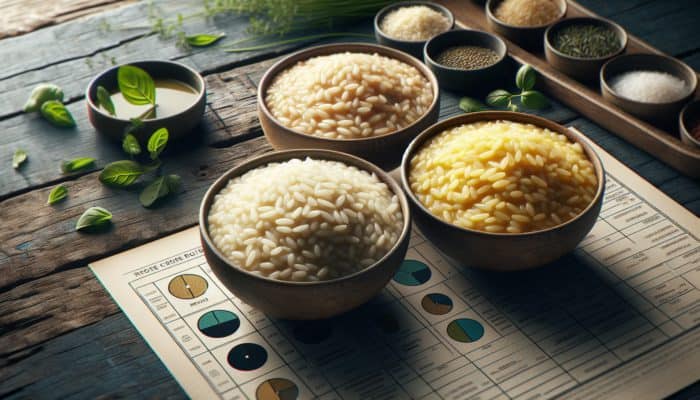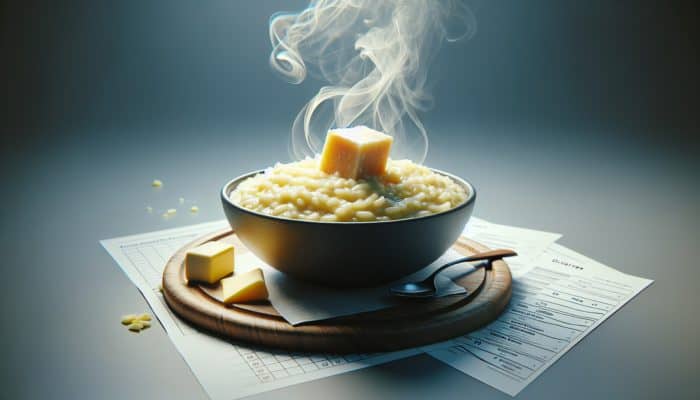Unlocking the Secrets to Perfectly Creamy Risotto: Essential Ingredients
Selecting the Best Rice for Achieving Creamy Risotto Perfection

To achieve the most luxurious, creamy Risotto, choosing the ideal type of rice is absolutely crucial. Varieties such as Arborio, Carnaroli, and Vialone Nano are particularly celebrated for their high starch content, which is fundamental for producing the rich, velvety texture that characterises expertly crafted Risotto. Each variety brings unique attributes to the dish, significantly influencing its creaminess and flavour profile. Grasping these distinctions empowers you to tailor your Risotto to meet your personal preferences and the specific culinary masterpiece you intend to create.
- Arborio: The most frequently used variety, known for its short, plump grains that excel in liquid absorption.
- Carnaroli: Often dubbed the “king” of risotto rice, it boasts a higher starch content and a firmer texture, ideal for achieving that desired creamy result.
- Vialone Nano: Acknowledged for its unique mix of creaminess and al dente texture, highly esteemed in regional Venetian dishes.
- Baldo: Comparable in quality to Arborio, it possesses good starch properties, although it may be harder to find.
- Roma: Although not traditional, it can yield acceptable results if cooked correctly.
The selection of rice plays a pivotal role in determining the final result of your Risotto. For those eager to venture beyond conventional choices, Carnaroli offers a more indulgent texture, while Vialone Nano brings a regional nuance worth delving into. Your rice choice should not only mirror your desired texture but also reflect the culinary traditions you aim to embrace, ultimately amplifying your overall cooking journey.
Understanding the Impact of Broth on Enhancing Risotto’s Creamy Texture
The type of broth employed in Risotto is paramount for enriching both the flavour and achieving that iconic creamy texture. A well-crafted broth provides the essential foundation of the dish, infusing the rice with flavour while allowing it to absorb the moisture necessary for optimal cooking. For the best results, homemade broth made from chicken, beef, or a blend of vegetables is often preferred. However, high-quality store-bought alternatives can also deliver satisfactory results when time constraints arise.
When selecting broth, chicken or vegetable options are commonly preferred, although seafood broth can elevate a Seafood Risotto with its briny depth and complexity. The key is to ensure that the broth is well-seasoned, as this will directly influence the flavour profile of your Risotto. It is advisable to warm the broth prior to incorporating it into the rice, as this prevents sudden temperature drops that could disrupt the cooking process and texture.
The Essential Role of Fats in Crafting Creamy Risotto
In the art of creating creamy Risotto, fats are indispensable in achieving a rich and satisfying mouthfeel. Both butter and olive oil serve not only to sauté the aromatics at the beginning of the cooking journey but also impart a luxurious richness to the finished dish. Olive oil lends a fruity, nutty flavour, while butter contributes a silky creaminess that envelops the rice grains, enhancing both taste and texture.
The inclusion of fats is crucial for emulsifying the Risotto, aiding in binding the starches released during cooking into a creamy sauce. As you stir the rice and gradually introduce broth, the fats coat the grains, elevating the overall mouthfeel. This interaction between fat and starch is what transforms Risotto from mere cooked rice into an exquisite culinary experience. Paying careful attention to the type and quantity of fat used is vital; insufficient fat may result in a lackluster dish, while an overabundance can overpower the delicate balance of flavours.
Proven Techniques for Perfecting Your Creamy Risotto

Mastering the Stirring Technique for Risotto Success
Stirring is far from a mundane task when it comes to preparing Risotto; it is a core technique that significantly influences the final texture. Continuous stirring facilitates the release of starch from the rice grains, creating that creamy, luxurious sauce that epitomises a well-crafted Risotto. The objective is to attain a harmonious fusion where the rice absorbs the broth uniformly while preserving a slight firmness characteristic of premium Risotto.
To refine the stirring technique, commence by heating your pan and introducing your chosen fats to sauté the aromatics. Once the rice is lightly toasted, add a ladleful of broth and begin stirring. A wooden spoon is preferred for this task, as it allows for better control and even heat distribution. Stir gently yet consistently, ensuring you scrape the bottom of the pan to prevent any sticking or burning.
As the liquid is absorbed, gradually add more broth while continuing to stir. This process typically spans around 18-20 minutes. You will know it’s time to cease stirring when the Risotto reaches that perfect creamy consistency without becoming overly mushy. This technique not only enhances the texture but also enriches the overall flavour, as the ingredients meld beautifully through your attentive manipulation.
The Importance of Gradually Adding Broth During Risotto Preparation
Incorporating broth gradually is a pivotal technique for crafting creamy Risotto, ensuring a consistent texture while preventing the rice from overcooking. This method entails adding small amounts of broth at a time, allowing the rice to fully absorb the liquid before introducing more. This approach maximises starch release from the grains, leading to that sought-after creaminess.
Begin with a ladleful of broth, pouring it into the rice only after the previous addition has been absorbed. While this process may seem tedious, it is crucial for achieving that flawless Risotto. Notably, esteemed chef Massimo Bottura champions this method, underscoring that slow cooking allows flavours to develop fully. Using a high-quality broth also contributes significantly to the dish’s flavour profile, so keep it warm on the stove for easy access.
Real-world examples, such as preparing a Mushroom Risotto, underscore the importance of this gradual addition. As the mushrooms release their moisture, they infuse the dish with rich umami. However, without the methodical incorporation of broth, the delicate balance could be compromised, resulting in a clumpy texture rather than the desired creaminess.
Final Touches to Amplify Creaminess in Your Risotto

The finishing touches you add to your Risotto are paramount for enhancing its creaminess and overall flavour. Including ingredients such as Parmigiano-Reggiano, cream, or additional butter just before serving can infuse layers of richness that elevate the entire dish. These final ingredients should be introduced right before plating to maintain their integrity and effectiveness.
Parmigiano-Reggiano is a classic enhancement, grated finely and stirred in until melted. This not only contributes to the creamy texture but also adds a nutty, savoury depth that beautifully complements the foundational flavours. Alternatively, a splash of cream can provide an even richer mouthfeel. Some chefs favour finishing their Risotto with a dollop of butter, which adds glossiness and smoothness, elevating the overall dish.
Experimenting with various combinations can yield exciting variations. For an indulgent finish, consider drizzling truffle oil, which can transform a simple Risotto into an extravagant dish. The key lies in tasting as you go, ensuring that the balance of flavours and textures is just right before serving to your guests.
Achieving the Perfect Risotto Texture: Key Considerations
The Vital Role of Starch in Crafting Creamy Risotto
The starch content found in risotto rice is indispensable for attaining that signature creamy texture that is so highly coveted. As the rice cooks, it releases starch into the liquid, forming a natural sauce that binds the grains together. This process is essential for striking the perfect balance between the firmness of the rice and the creaminess of the dish.
When rice grains are stirred continuously, they rub against one another, releasing more starch into the mixture. This is why Risotto is traditionally stirred rather than left unattended. The ideal amount of starch released will yield a Risotto that is creamy yet maintains its structure. Grasping this balance is crucial; too little starch can result in a dry dish, while excessive starch can lead to an undesirable gummy texture.
Various cooking techniques also influence the release of starch. The initial toasting of the rice helps lock in moisture while preparing it for cooking. As you gradually add broth and stir, you will notice how the texture gradually transforms. The goal is to achieve a creamy consistency where each grain is perfectly coated, retaining its shape, resulting in an exquisite dish.
Determining the Optimal Cooking Time and Temperature for Risotto
The appropriate cooking time and temperature for Risotto are fundamental in achieving the perfect texture. Risotto should be cooked over medium heat, allowing for even absorption of the broth without the risk of burning or uneven cooking. Generally, it takes about 18-20 minutes from the initial addition of broth to reach the desired creamy consistency.
Throughout the cooking process, it is critical to monitor the temperature closely. High heat cooks the rice too quickly, leading to an uneven texture and possibly burning the bottom. Conversely, if the heat is too low, the rice will absorb the broth too slowly, resulting in an overcooked, mushy texture. A constant simmer is essential, allowing the rice to absorb the liquid gradually while providing ample time to release starch.
As the cooking time progresses, continuously test the rice for doneness. It should be creamy with a slight bite to the grain, known as “al dente.” When you achieve this perfect balance, your Risotto is ready to be enhanced with finishing ingredients, ensuring that every bite is a delightful combination of creaminess and texture that will please your palate.
The Importance of Allowing Risotto to Rest for Texture Perfection
Allowing your Risotto to rest before serving is an often-overlooked yet essential step in achieving the perfect consistency. Resting permits the rice to absorb any remaining liquid, helping the dish reach an optimal texture. This resting phase can elevate a good Risotto into an exceptional one by allowing the flavours to meld and the creaminess to settle.
The ideal resting time is typically around 2-3 minutes after cooking. During this period, the starches continue to work their magic, thickening the sauce while ensuring that it remains creamy without becoming overly dense. Covering the pot with a lid during this time helps retain heat, allowing the residual steam to further enhance the dish.
Resting is particularly beneficial if you have added finishing touches like cheese or butter, as it gives them time to fully incorporate into the Risotto. After resting, gently fluff the Risotto with a fork before serving, allowing for an airy texture that complements its creamy nature. This small yet critical step ensures that each portion remains cohesive and indulgently delicious, ready to impress your guests.
Avoiding Common Pitfalls When Making Risotto
How to Prevent Overcooking the Rice in Your Risotto?
One of the most frequent mistakes when preparing Risotto is overcooking the rice, which results in a mushy texture devoid of the desired creaminess. Overcooked rice can be unappetizing and lose its structure, leading to a uniform, unappealing consistency that detracts from the overall appeal of the dish.
To avoid overcooking, it is essential to closely monitor the rice throughout the cooking process. The ideal texture should be creamy and al dente, with a slight firmness that allows the grains to maintain their shape. Tasting regularly during the final stages of cooking will provide insights into the rice’s doneness. If you notice the rice becoming too soft, it is crucial to reduce the heat and adjust the cooking time accordingly.
Another helpful tip is to keep an eye on the quantity of broth added. If too much liquid is introduced too quickly, it can lead to unintended softening of the rice. Gradually adding broth allows for better control over the cooking process. Maintaining the right heat level and stirring consistently will help ensure that the rice cooks evenly without becoming mushy, resulting in a delectably creamy Risotto.
The Consequences of Using the Wrong Type of Rice for Risotto
Choosing an inappropriate type of rice can severely compromise the quality of your Risotto. Varieties such as long-grain rice or basmati are unsuitable for Risotto because they lack the essential starch content required to create the desired creaminess. When these types of rice are used, you may end up with a dish that is dry and devoid of the luscious texture typical of authentic Risotto.
The best options for Risotto are short-grain varieties like Arborio, Carnaroli, and Vialone Nano, each possessing a high starch content ideal for creamy dishes. The starches released during cooking are what create the signature silky sauce. If you mistakenly choose a non-risotto rice, you will likely end up with a watery dish, far from the intended creamy texture.
It is crucial to pay careful attention to the type of rice selected, as it is foundational to the success of the dish. Investing time in understanding the characteristics of different rice varieties will serve you well in the long run, enhancing your Risotto-making skills and ensuring consistently delicious outcomes.
The Dangers of Rushing the Cooking Process in Risotto Preparation
Rushing the cooking process is a common error that can lead to disappointing results when preparing Risotto. This dish demands patience and focus, as it requires time to develop its flavours and achieve the perfect creamy consistency. Trying to hasten the process can result in uneven cooking and a final product that lacks the desired texture.
Risotto necessitates a gradual method, especially concerning broth addition and stirring. When broth is added too quickly, it can overwhelm the rice, causing uneven cooking and hindering proper starch release. Signs of rushed Risotto typically include a soupy texture and undercooked rice, which can be quite unsatisfactory.
To mitigate this, concentrate on maintaining a steady, manageable pace throughout the cooking process. Allow each addition of broth to be completely absorbed before adding more, and stir consistently to promote even cooking. By respecting the time and effort involved in making Risotto, you will be rewarded with a dish that embodies the rich, creamy qualities that make it a cherished classic in Italian cuisine.
Proven Strategies for Perfecting Creamy Risotto Techniques
Toasting Rice for Enhanced Flavour in Risotto
Toasting the rice before adding liquid is a technique often overlooked, yet it significantly elevates both flavour and texture. This method involves heating the rice in the pan with a source of fat, such as olive oil or butter, until the grains become slightly translucent and aromatic. This initial step is crucial for developing a deeper, more nuanced flavour profile in the final dish.
The benefits of toasting rice extend beyond flavour; it also helps create a barrier that protects the grains during the cooking process. This ensures that when you add broth, the rice absorbs it evenly, preventing the grains from becoming overly mushy. The result is a Risotto that has a pleasing bite while still being enveloped in a creamy sauce that delights the palate.
Expert chefs recommend toasting for just a few minutes until the rice is coated and fragrant. This transformative step elevates your Risotto from a simple side dish to a culinary delight, showcasing a depth of flavour that excites the senses and enhances the overall dining experience.
How to Layer Flavours for Maximum Impact in Risotto
Layering flavours in Risotto is an art that can significantly enhance the dish’s complexity and enjoyment. By adding ingredients at different stages during the cooking process, you can create a harmonious blend of flavours, ensuring that each component shines through while contributing to the overall experience.
Begin by sautéing aromatics such as onions or shallots in your chosen fat to form the flavour base. Once softened, add the rice and toast it lightly, allowing it to absorb the flavours of the aromatics. As you gradually add broth, consider incorporating additional ingredients such as mushrooms, herbs, or vegetables at varying intervals; for instance, adding mushrooms early on allows them to impart their essence into the dish, while fresh herbs can be stirred in at the end for a bright, vibrant finish.
Utilising this layering technique can elevate your Risotto to new culinary heights. By creating depth through careful timing of ingredient additions, you’ll cultivate a dish that not only boasts a creamy texture but also a complex flavour profile that invites exploration with every delectable bite.
Steps to Achieve the Right Consistency in Risotto
Achieving the perfect Risotto consistency is a delicate balance between creaminess and texture. The ideal Risotto should be thick enough to hold its shape slightly when plated but still ooze a creamy, sauce-like quality. To reach this level of perfection, several specific steps must be followed diligently.
- Start with the right rice: Choose short-grain varieties known for their starch content, such as Arborio or Carnaroli.
- Toast the rice: Heat in fat for a few minutes to develop flavour and create a barrier for moisture retention.
- Add broth gradually: Incorporate ladlefuls of warm broth slowly, allowing each addition to be completely absorbed before the next.
- Stir consistently: Keep stirring to release starch and promote a creamy texture.
- Test for doneness: Taste the rice frequently to ensure it reaches al dente, maintaining a slight bite.
- Finish with fats: Add butter and cheese at the end for an extra layer of creaminess.
- Rest before serving: Allow the Risotto to sit, covered, for a few minutes to further enhance its texture.
By diligently following these steps, you will create a Risotto that achieves the ideal balance of creaminess and texture, allowing each grain to shine within a rich, cohesive sauce that is sure to impress your guests.
Choosing the Right Rice Variety: The Key to Creamy Risotto
Choosing the correct rice variety is fundamental to crafting a truly creamy Risotto. Not all rice is created equal; the right type can significantly impact the dish’s outcome. The most commonly used varieties include Arborio, Carnaroli, and Vialone Nano, each offering unique characteristics, a recognisable texture, and flavour.
Arborio rice is the most widely recognised, known for its plump grains and ability to absorb liquid while retaining a slightly firm bite. Its high starch content makes it a staple for many Risottos. Carnaroli, often considered the superior choice, contains even more starch and retains its firmness during cooking, making it ideal for achieving a creamy texture. Lastly, Vialone Nano, with its shorter grains, is celebrated for its ability to absorb flavour while maintaining a tender texture, making it a favourite among chefs.
When selecting your rice, consider the dish you wish to create. For a luxurious seafood Risotto, Carnaroli is often favoured for its rich mouthfeel, while Arborio serves well for traditional recipes. Understanding the differences among these rice types will empower you to make informed choices, ensuring your Risotto achieves the desired creaminess and flavour that will delight your diners.
Exploring Exciting Variations of Creamy Risotto
Delighting in the Classic Risotto Milanese
Risotto Milanese stands out as a variation that elevates traditional Risotto with the luxurious addition of saffron, imparting a distinctive golden hue and a unique flavour profile. This classic dish originates from Milan and is often associated with celebrations and special occasions, showcasing the finesse of Italian culinary artistry.
What sets Risotto Milanese apart is not only its vibrant colour but also its aromatic depth, achieved by steeping saffron threads in broth before being added to the rice. The use of butter and Parmigiano-Reggiano further enriches the dish, resulting in a creamy, indulgent texture that beautifully complements the delicate saffron notes.
To prepare this Risotto, begin by toasting the rice as usual, then gradually incorporate the saffron-infused broth while stirring constantly to achieve that signature creaminess. The saffron not only enhances the colour but also provides an earthy, floral aroma that distinguishes it from more standard Risottos. This variation is a testament to the beauty of Italian cuisine, showcasing how simple ingredients can be combined to create an extraordinary dish that captivates the senses.
The Luxury of Seafood Risotto
Seafood Risotto represents a luxurious twist on the classic recipe, incorporating a variety of fresh seafood to create a rich and flavourful dish. This variation allows for creativity, as you can tailor the seafood components to reflect local offerings or personal preferences.
When preparing seafood Risotto, it is essential to select fresh ingredients like prawns, scallops, clams, or squid, as their flavours elevate the overall dish. The cooking technique remains consistent with traditional Risotto; however, timing is crucial. Seafood should be introduced toward the end of the cooking process to prevent overcooking, which can lead to a rubbery texture that detracts from the dish’s appeal.
Consider using a seafood broth for added depth or even incorporate the shells of the seafood into your base broth for a richer flavour profile. This method can significantly enhance the umami notes in your Risotto, making each bite a delectable experience. The combination of creamy rice with tender seafood creates a dish that is both comforting and refined, perfect for special occasions or a sophisticated weeknight dinner that will impress your guests.
Creating Delicious Vegetarian Risotto Options
Vegetarian Risottos offer a delightful alternative that showcases the versatility of this dish, allowing for an abundance of flavours and colours. By incorporating a variety of seasonal vegetables, you can create a vibrant and nutritious Risotto that appeals to both vegetarians and meat-eaters alike.
Popular vegetarian ingredients include:
- Asparagus
- Mushrooms
- Peas
- Spinach
- Butternut squash
- Tomatoes
- Artichokes
- Broccoli
Each of these ingredients brings its unique flavour and texture to the dish. For instance, adding asparagus and peas in the final stages of cooking offers a fresh, bright element, while mushrooms can be sautéed at the beginning to impart deep, earthy flavours. When incorporating vegetables, consider their cooking times to ensure they retain their integrity and complement the creamy texture of the Risotto.
A well-executed vegetarian Risotto can be just as indulgent as its meat-based counterparts, proving that this dish can cater to a variety of dietary preferences while remaining thoroughly satisfying and delicious, making it a fantastic choice for any occasion.
The Allure of Mushroom Risotto
Mushroom Risotto is a beloved variation that enhances the creamy base with the earthy richness of mushrooms. This dish showcases how different mushroom types can dramatically impact flavour and texture, making it a favourite among both mushroom lovers and Risotto enthusiasts.
When preparing mushroom Risotto, consider using a mix of mushrooms for complexity. Options like shiitake, cremini, and portobello can provide a range of flavours from mild to robust. Start by sautéing the mushrooms at the beginning of the cooking process to develop their flavour and allow them to release their moisture, enriching the broth and enhancing the overall dish.
The technique remains consistent with traditional Risotto, involving the gradual addition of broth and continuous stirring to achieve that creamy texture. As the mushrooms blend with the rice, they contribute to the overall depth of umami, making each bite a rich and indulgent experience that is sure to satisfy. For an added touch, finish with a sprinkle of fresh herbs like thyme or parsley to brighten the dish and elevate the mushroom notes, creating a truly memorable meal.
Enhancing Risotto with Additional Ingredients: A Culinary Adventure
Incorporating Proteins into Your Risotto for Depth and Flavor
Integrating proteins into Risotto can add depth and substance, transforming a simple dish into a hearty meal. Various meats, such as chicken, pork, or even beef, can be utilised to enhance the flavour and nutritional value of the dish, making it more satisfying.
For chicken Risotto, consider using diced chicken thighs for their succulent texture. Sauté the chicken first before adding the rice, allowing it to develop a nice sear that infuses the dish with rich flavours and enhances the overall experience. Pork can be introduced in the form of pancetta or chorizo, adding a salty, savoury element that beautifully complements the creaminess of the Risotto.
For a seafood twist, incorporating shellfish like prawns or scallops can significantly elevate the dish. Their delicate flavours pair perfectly with the creamy rice, creating a luxurious dining experience that is both comforting and elegant. The key is to time the addition of proteins correctly, ensuring they are cooked to perfection without becoming tough or overdone, resulting in a delightful meal that showcases the versatility of Risotto.
Adding Vegetables for Enhanced Nutrition and Flavor
Vegetables play a crucial role in enhancing both the nutrition and visual appeal of Risotto. By introducing seasonal vegetables, you not only add colour but also texture and flavour to the dish, creating a well-rounded meal that is both satisfying and delicious. Cooking vegetables alongside the rice can create a harmonious blend of tastes and help to brighten the overall profile.
Incorporating vegetables like peas or spinach towards the end of the cooking process allows them to retain their vibrant colours and fresh flavours, adding a lovely contrast to the creamy rice. For heartier vegetables, such as butternut squash or carrots, consider sautéing them to caramelise or soften them before adding the rice. This method allows their natural sugars to caramelise, enriching the Risotto with additional sweetness and depth of flavour.
Herbs, such as basil or parsley, can also be added in the final stages to provide a fresh lift and aroma. The combination of creamy Risotto with a variety of vegetables not only enriches the dish nutritionally but also creates a visually stunning presentation that is sure to impress your guests and make every meal a delightful experience.
Utilising Herbs and Spices to Elevate the Flavors of Risotto
Herbs and spices are powerful tools for enhancing the flavour profile of Risotto, allowing for a range of creative interpretations. Fresh herbs, in particular, can brighten the dish, while spices can introduce warmth and depth that enhance the overall experience.
Classic herbs to consider include parsley, basil, and thyme, which can enhance the overall complexity of the dish. Adding chopped herbs just before serving helps maintain their vibrant colours and fresh flavours, providing a stunning contrast against the creamy backdrop of the Risotto, which will excite the palate.
Spices also play a transformative role; for instance, a dash of nutmeg can add warmth, while a sprinkle of smoked paprika can introduce a subtle smokiness that complements the dish beautifully. Experimenting with different flavour combinations invites you to explore exciting new iterations of Risotto, turning each preparation into a culinary adventure filled with delightful surprises.
Frequently Asked Questions About Risotto Mastery
What is the best rice for making Risotto?
The best rice for making Risotto is short-grain varieties like Arborio, Carnaroli, and Vialone Nano, which have a high starch content essential for achieving the desired creaminess.
Can I use broth from a carton for Risotto?
Yes, high-quality store-bought broth from a carton can be used for Risotto, but homemade broth often yields superior results in terms of flavour and richness.
How long should I cook Risotto?
Typically, Risotto should be cooked for approximately 18-20 minutes, involving gradual broth additions and consistent stirring to reach the perfect texture.
What can I add to Risotto for extra creaminess?
For extra creaminess, consider incorporating finishing ingredients like butter, cream, or grated Parmigiano-Reggiano just before serving to enhance the dish’s luxurious texture.
Should I cover the Risotto while cooking?
It’s best to leave Risotto uncovered during cooking to allow moisture to evaporate and ensure even cooking, resulting in the ideal creamy consistency.
Can I make Risotto ahead of time?
While it’s best served fresh, Risotto can be prepared ahead and reheated, but it may require additional broth to regain its creamy consistency and prevent drying out.
What are some common mistakes when making Risotto?
Common mistakes include overcooking the rice, using the wrong type of rice, or rushing the cooking process, all of which can negatively affect the dish’s texture and flavour.
How do I know when Risotto is done?
Risotto is considered done when it reaches a creamy consistency and the rice is al dente, with a slight bite to the grain that enhances the overall experience.
Can I freeze Risotto?
Yes, Risotto can be frozen, but it’s best to store it in individual portions and reheat gently with added broth to restore its creamy texture.
What vegetables work best in Risotto?
Vegetables such as peas, asparagus, mushrooms, and spinach are exceptional choices for Risotto, adding flavour, nutrition, and vibrant colour to the dish.
Stay updated with our latest posts on Facebook!
The post Techniques for Making Creamy Risotto: A Universal Guide appeared first on https://cookinggods.com
The Article Creamy Risotto Techniques: Your Ultimate Guide Was Found On https://limitsofstrategy.com
References:
https://limitsofstrategy.com/creamy-risotto-techniques-your-ultimate-guide/



